Finding the perfect sofa colour combination for your space can be a daunting task. But with a few simple tips and tricks, you can easily find the perfect mix of hues to create an inviting and stylish atmosphere in your home.
As an experienced interior designer at Nousdecor, I’m here to show you how to choose just the right Sofa Colour Combinations that will bring out all of the best features in your room.
From selecting a primary colour and accenting it with complementary shades to testing out different textures and considering the lighting in the room, this guide will help you make informed decisions about which combinations will work best for you.
Key Takeaways of Sofa Colour Combinations
- Consider colour theory and the three primary colours (red, blue, and yellow)
- Mix and match shades to create an inviting atmosphere
- Test out colours before making a commitment
- Use artwork and accessories as inspiration for finding the right hue of couch fabric
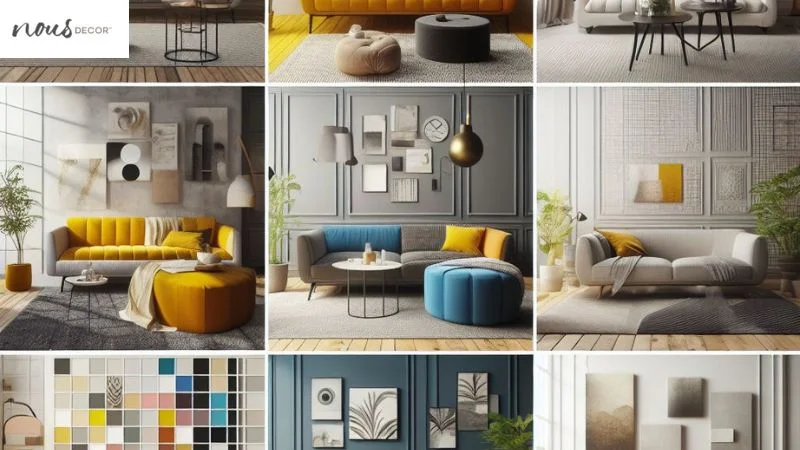
Consider Your Colour Palette
Choosing a colour palette for your sofa can be fun and exciting! Understanding the basics of color theory can help you craft a look that truly stands out.
Start by considering the three primary colors: red, blue, and yellow. Each of these colors are associated with different emotions and feelings, so take some time to think about how each might complement your home’s décor. From there, you can begin to mix-and-match various shades from within this trio to create an inviting atmosphere.
Additionally, consider colors found in the room itself. Are there any wallpapers or rug patterns that could inspire the sofa’s color scheme? Take note of these details and determine what hues would enhance them best. You may also want to think about furniture pieces within the space – such as tables or lamps – and use their colors as part of your inspiration when selecting a sofa shade.
Once you have identified some potential options, make sure to test them out before making a commitment! Get swatches from fabric stores or borrow samples online if necessary; seeing the colors up close will give you an idea of how they will look together in real life before taking the plunge and investing in new furniture.
With careful consideration given to both practicality and aesthetics – along with plenty of experimentation – you’ll be able to find just the right combination for your living area. With all this taken into account, you’ll have chosen a vibrant palette that suits your unique style perfectly!
Take Note of the Room’s Features
Take note of the features in your room – it’s important to pick a colour combination that works with them. Whether you have existing furniture, built-ins, wall colour and art or other decor, each one plays a role in the overall look of the room. Consider these elements when selecting your sofa colours:
| Element | Impact on Sofa Colour Choice |
|---|---|
| Wall Colour | Choose complementary shades for the walls and sofa fabric. Avoid matching too closely as this can be overwhelming. |
| Furniture & Decor | Pick a neutral tone for the sofa if there are many colors in the room already. Alternatively, choose an accent color from another piece of furniture or an area rug to match upholstery with. |
| Artwork & Accessories | Consider adding a bolder shade by selecting an artwork that ties into your desired palette and use it as inspiration for finding just the right hue of couch fabric. |
| Lighting | Low lighting creates a softer atmosphere while brighter light reflects more off surfaces so take this into account when picking out your fabric choice. For example, opt for velvet over silk under bright lights, as silk can appear too shiny and reflective in such conditions. |
The key is to create harmony between all these different elements using carefully chosen shades of fabrics and finishes – not everything has to be perfectly matched but they should work together harmoniously nonetheless!
To achieve this balance focus on creating contrast rather than exact matches; consider opting for complimentary tones instead of identical hues throughout the space. Finally, trust your instincts – if something feels wrong then try something else!
Choose Your Primary Colour
Creating the perfect look for your room starts with picking the right primary colour. Whether you want to go bold and daring, or subtle and timeless, having a plan for your multicolored couches in living space helps tie together all of the elements in your space.
To get started, identify any existing colours in the room that you’d like to work around. These can be colours from artwork, rugs, curtains or even furniture pieces that are staying put. From there, pick a base colour for your sofa that harmonizes with these existing hues while still making a statement of its own.
Neutrals like white, taupe and gray are safe bets if you’re aiming for an understated yet modern look. Or go big by choosing something more adventurous like turquoise blue or emerald green – just make sure it blends well with other shades in the area.
If you have multiple seating areas within one room (e.g., a living-dining combo), opt for two slightly different shades of the same colour family to create an intentional contrast without overwhelming the eye.
With just one key decision made, you’re now ready to incorporate accent colours and get closer to achieving your dream home decor!
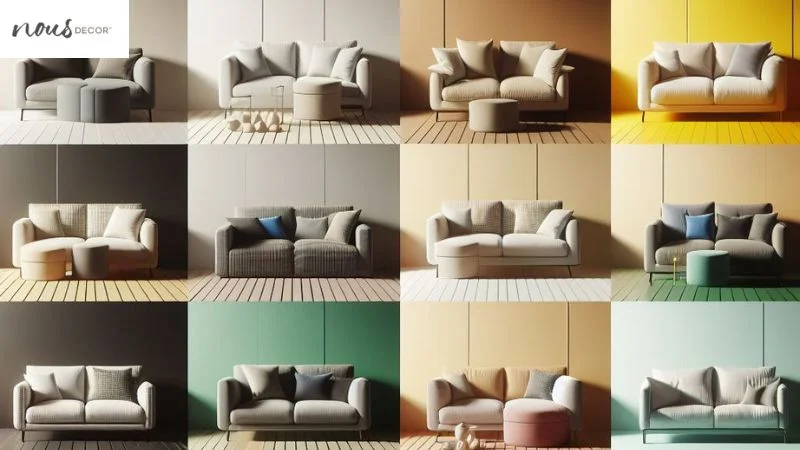
Pick an Accent Colour
Amp up your living space with an accent colour that complements your already-chosen primary hue! Choosing the right accent colour for your sofa can be tricky, but it’s well worth the effort to get it just right.
Start by considering the undertones of the primary colour you’ve chosen. For example, if you selected a bold red for your sofa, then opting for a deep blue or green as an accent will help create balance in the room. If you went with a pastel yellow sofa instead, consider pairing it with pinks and purples to create a soft and inviting feel.
Darker colours such as navy blue (see colors that go well with blue sofa) and black (see coordinating colors for black sofa) offer contrast against lighter shades of primary hues like white or ivory. You can also choose from jewel tones such as magenta or emerald green to add depth and vibrancy to any room.
To make sure all the colours work together in harmony, try borrowing from one of the secondary colours present in your chosen primary hue. This will ensure that all elements of your piece tie together nicely without being too overwhelming or busy.
For those who prefer more muted tones, beiges (see stylish beige sofa palettes), greys (see complementing curtains for grey couch), and tans are excellent choices when selecting an accent colour for their sofas.
These neutral shades bring subtlety while still providing visual interest to any space – plus they look great when paired with brighter hues like yellows and oranges!
When adding a neutral tone into your overall scheme, make sure there is enough contrast between shades so that each element stands out on its own without competing for attention (see dual-tone sofas in living room for more color contrast guide).
If your sofa is brown colored, check out our articles on Colours That Go With Brown Sofa and dark brown sofa decor inspiration now!
Next step is to include a neutral shade into your overall palette – this allows you to bring out subtle details without taking away from other elements in the room.
Include a Neutral
Adding a neutral shade to your palette can help bring out subtle details without detracting from other elements in the room, giving you a space that’s inviting and cozy. Neutral shades are great for grounding the look of any sofa set and allowing bolder colors to stand out.
From light beiges to dark charcoals, there is a wide range of neutrals available that will complement nearly any color scheme. When deciding on what neutral shade to choose, consider your existing furniture pieces and wall colors as these should be taken into account when selecting the right one for your sofa set.
Neutral shades also offer more versatility when it comes to changing up your decor in the future. If you decide you want to update with some new pillows or throws, you won’t have to worry about them clashing with your sofa color since neutrals blend easily with almost any other hue.
To ensure all other colors remain balanced throughout the space, try sticking with two or three different tones: one bright color plus two complementary neutrals. This way everything will tie together nicely without becoming overwhelming or distracting from each other’s beauty.
When it comes to picking out textiles for seating, neutrals are always a safe choice as they give off an effortless elegance while still being comfortable enough for everyday use.
A combination of natural fibers like cotton and linen add texture and depth while also making sure no single piece stands out too much against its surroundings; this can make it easier if you ever want to switch up the style down the line by adding pops of brighter hues here and there.
Including a neutral shade in your sofa colour scheme is an excellent way to create harmony within any living space while still allowing individual pieces of furniture or artwork stand out on their own terms.
With careful consideration in mind, finding just the right combination doesn’t have to feel daunting – instead think about how different textures can further enhance your design before making any final decisions!
Consider Different Textures
Exploring different textures when selecting your seating pieces is a great way to bring dimension and interest to your space. From velvet sofas that add a touch of luxury, to linen upholstery with its traditional look, there are countless options available.
Here are some tips for choosing the perfect combination:
- Think about how you use the room: Will it be an area for entertaining guests or for relaxing after a long day?
- Consider both practicality and style: Pick materials that can withstand everyday wear and tear while still matching your aesthetic.
- Look at what’s around it: If you’re pairing two different fabrics, make sure they complement each other in terms of patterns and colors.
- Don’t forget about texture: When deciding on the fabric type, feel samples of various textures like crushed velvet or corduroy to find one that suits you best.
The choices are endless but by keeping these tips in mind, you’ll be able to create the sofa combination perfect for your home. And if your couch is burgundy, why not check out our article on coordinating walls with burgundy sofa now?
Now it’s time to think about how the room’s lighting will affect your color decisions.
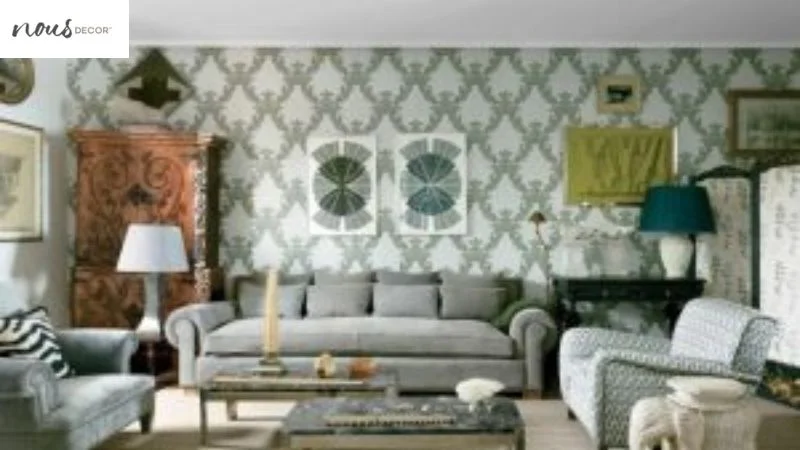
Think About the Room’s Lighting
Take a moment to consider how the lighting in your room will affect the look of your seating pieces – it could make a huge difference! Bright lights can give off an overly harsh, stark impression, while dimmer lighting can create a more subdued and inviting atmosphere.
Balance is key when selecting sofa colour combinations – you don’t want one to overpower the other. Natural light is often best as it creates an aura of warmth and vibrancy, but if you’re not blessed with abundant natural light then use lamps or accent lighting to brighten up dark corners.
Additionally, take into account what type of colour temperatures are used in the room’s bulbs – warm-toned bulbs provide a softer feeling, whereas cool-toned bulbs offer more contrast and clarity. Experiment with different options for a few days before making any decisions so that you get an idea of how each option impacts the overall look of your space.
Once you’ve settled on your preferred combination of bulb temperature and intensity, it’s time to test out your chosen colour combinations for the sofa itself. Take into account both direct and indirect light sources such as windows, skylights or artificial light sources like table lamps or wall sconces.
See how each hue looks under various types of illumination to ensure that no matter what time of day it is, your living area will always look its best.
Test Out Your Colour Combinations
Experimenting with various lighting scenarios can help you to determine the ideal colour pairings for your seating area, allowing you to create a truly inviting atmosphere.
Start by bringing in swatches of fabric or paint samples and move them around each space in the room according to how you plan on positioning the furniture. It’s best to use natural light whenever possible as it gives an accurate representation of colours.
You might find that two complementary hues work together better than one bold tone, or vice versa – experimentation is key!
Don’t be afraid to think outside the box when it comes to sofa colour combinations; try using shades that don’t match exactly but still blend well together. For example, a goldenrod yellow and a sage green can look great together if paired correctly. Also consider adding contrast through textures such as velvet and linen, or metallic accents like silver or brass.
Choosing your sofa color should be an enjoyable experience so take your time and really think about what type of ambiance you want to create with your design choices. Keep in mind that lighter colors usually make a space feel larger while darker tones make it seem cozier; this could affect which direction you go in terms of selecting colors.
Additionally, remember that any patterned fabrics will need coordinating solids or stripes for balance – no matter how small they may appear at first glance!
No matter what combination you ultimately decide upon, be sure to test out several different options before committing so that you know for sure it’s going to look good once all pieces are in place. Experimentation is key!
Having fun with color can turn an ordinary living room into something extraordinary – get creative and enjoy finding the perfect sofa colour combination for your home!
Frequently Asked Questions
Conclusion
I’m confident that with the right Sofa Colour Combinations, my couch will be a show stopper. By considering the room’s features, choosing a primary and accent colour, adding in neutrals, and mixing different textures, I’m sure to get the perfect look for my living space.
Lighting is also an important factor so I’ll have to make sure it complements my chosen colours. With all of these tips in mind, I’m ready to find the perfect sofa colour combination!
Interested in getting your own sofa? Check out our article on the best sofas on the market now!

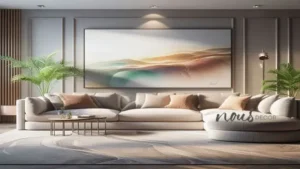
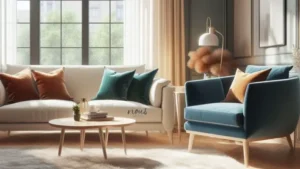
![Power vs Manual Recliner Sofa: What’s The Difference? [2024]](https://nousdecor.com/wp-content/uploads/2021/06/power-vs-manual-recliner-sofa-300x169.webp)


